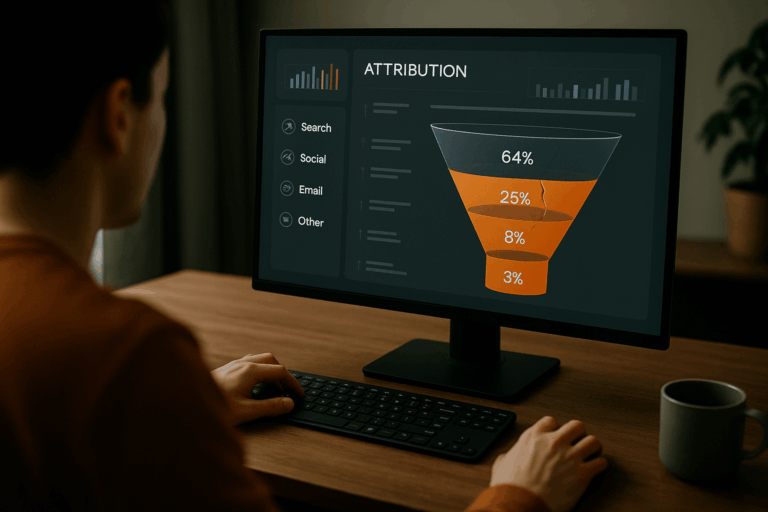The DTC Halo Effect: Why Retail Media Measurement Needs a Reset

- 1. Why the Measurement Problem Matters
- 2. Retail Media Today: Bigger Than Sponsored Listings
- 3. Why Traditional Retail Media Measurement Falls Short
- 4. Measuring the DTC Halo Effect
- 5. 1. Matched Market Testing (MMT)
- 6. 2. Marketing Mix Modeling (MMM)
- 7. The Risks of Siloed Measurement
- 8. The Business Case for Smarter Retail Media Measurement
- 9. The Road Ahead: Standards and Systems
Why the Measurement Problem Matters
Retail media is exploding. Amazon Ads, Walmart Connect, Target Roundel, Kroger Precision Marketing, Instacart Ads, and dozens of other retail media networks are capturing billions in ad spend. For DTC brands, the opportunity is obvious: meet customers where they’re already shopping.
But retail and DTC performance are never isolated. Running ads on Amazon or Walmart doesn’t just lift sales on those platforms; it drives spillover effects across your DTC site and even in-store retail partners. At the same time, DTC campaigns often fuel Amazon and retail sales velocity. This is the DTC halo effect, and it’s exactly why siloed reporting creates blind spots.
If you only judge DTC campaigns by DTC revenue, you risk cutting spend that was actually driving incremental sales on Amazon or at another retailer. And if you only measure retail media by retailer dashboards, you miss the cross-channel impact that proves its true value. CFOs see weak CAC or inflated ROAS and cut budgets, but the brand ends up losing share and profitability that it can’t recover.
To avoid this, marketers need incrementality measurement that captures halo effects across both DTC and retail media.
Retail Media Today: Bigger Than Sponsored Listings
Retail media has grown far beyond Amazon sponsored products. Today’s retail media landscape spans:
-
Onsite retail media: sponsored products, sponsored display, search placements.
-
Offsite retail media: retailer-powered campaigns across social, CTV, and programmatic retargeting.
-
In-store retail media: connected shelf screens, digital signage, and location-based ad placements.
For most DTC brands, retail media is no longer optional. But success requires more than buying ad placements. It requires a retail media strategy that measures the full contribution of retail campaigns across the mix.
Why Traditional Retail Media Measurement Falls Short
Most retail media campaigns are judged by platform-reported ROAS or campaign dashboards. That creates three major problems:
-
Platform silos: Amazon, Walmart, Instacart, Sephora all report in their own black boxes with no standardization. No one tells you what’s happening to DTC sales. Oftentimes, the retail and DTC teams also work in silos.
-
Attribution inflation: Every platform claims credit for the same conversion. Amazon says it was their ad, Meta says retargeting, Google says branded search. The result is overstated performance and wasted ad spending.
-
Cross-channel blindness: Retail media investment often lifts DTC sales, and DTC spend often drives retail sales. Without incrementality measurement, you miss these halo effects entirely.
The result? Brands cut efficient spend, double-pay for sales, and slow growth.
Measuring the DTC Halo Effect
To move from attribution to contribution, brands need methods that measure incremental lift across both DTC and retail media networks. Three approaches stand out:
1. Matched Market Testing (MMT)
-
Select similar test and control markets.
-
Increase retail media spend in the test market, keep it steady in the control.
-
Measure total sales across DTC, Amazon, and retail partners.
-
The difference reveals incremental sales lift, including halo effects.
2. Marketing Mix Modeling (MMM)
-
Build a model using 2–3 years of sales data and ad spend across DTC, Amazon Ads, and other retailers.
-
Control for promotions, seasonality, competitor activity, and external factors.
-
Quantify how retail media spend contributes to total business outcomes, not just on-platform ROAS.
-
Media mix modeling gives the holistic view, while MMT and holdouts validate assumptions with causal evidence.
The Risks of Siloed Measurement
When retail media and DTC spend aren’t measured together, three things happen:
-
DTC budgets get cut: campaigns look inefficient in isolation, but may actually be driving Amazon or retail sales.
-
Retail wins get misattributed: Retailers claim credit for sales your DTC campaigns generated, meaning you pay twice for the same outcome.
-
Growth stalls: Without clarity, CFOs reduce marketing investment. Competitors who measure contribution instead of attribution take share.
The Business Case for Smarter Retail Media Measurement
-
Beauty brand case: A DTC skincare brand paused Meta prospecting because ROAS looked weak. MMM revealed those ads were fueling Sephora sales with an +18% lift. Cutting Meta slowed Sephora sell-through.
-
Food & beverage case: An Instacart Ads campaign lifted not only in-app baskets but also drove incremental Amazon Subscribe & Save orders. Without halo measurement, Instacart looked breakeven. With MMT, it proved a 2.2x iROAS.
-
CPG case: MMM analysis showed Walmart Connect campaigns were cannibalizing promo-driven sales, while DTC ads were lifting Amazon and Target performance. Budget reallocation improved ROI by +9% in a single quarter.
The Road Ahead: Standards and Systems
Retail media networks are growing fast, but measurement standards haven’t caught up. The IAB, Media Rating Council, Nielsen, Circana, and SPINS are all pushing toward retail media measurement standards, but today’s marketers can’t afford to wait.
The path forward is building systems that reflect contribution:
-
MMM to model long-term impact across DTC and retail.
-
MMTs (growth and holdout tests) to run causal experiments that validate halo effects.
-
Continuous optimization to reallocate spend based on incremental sales, not inflated ROAS.
Retail media is now one of the biggest line items in a brand’s marketing budget. Without incrementality testing, advertisers will keep overpaying for sales that would have happened anyway, while cutting spend that was actually driving growth.
The winners will be the brands that stop treating DTC and retail media as separate silos and start measuring them as a connected system. That’s how you capture the halo effect, protect your budgets, and build marketing effectiveness in a retail media landscape that’s only getting more competitive
Our Editorial Standards
Reviewed for Accuracy
Every piece is fact-checked for precision.
Up-to-Date Research
We reflect the latest trends and insights.
Credible References
Backed by trusted industry sources.
Actionable & Insight-Driven
Strategic takeaways for real results.






















